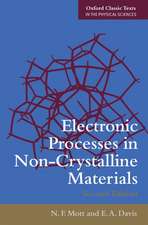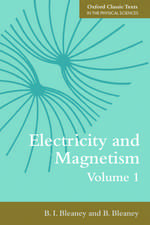Chemistry and Physics of Solid Surfaces IV: Springer Series in Chemical Physics, cartea 20
Editat de R. Vanselow, Russell Hoween Limba Engleză Paperback – 9 apr 2012
Din seria Springer Series in Chemical Physics
- 20%
 Preț: 585.30 lei
Preț: 585.30 lei - 15%
 Preț: 643.00 lei
Preț: 643.00 lei - 15%
 Preț: 635.96 lei
Preț: 635.96 lei - 18%
 Preț: 953.03 lei
Preț: 953.03 lei - 15%
 Preț: 644.63 lei
Preț: 644.63 lei - 15%
 Preț: 638.43 lei
Preț: 638.43 lei - 15%
 Preț: 649.22 lei
Preț: 649.22 lei - 15%
 Preț: 647.40 lei
Preț: 647.40 lei - 15%
 Preț: 638.89 lei
Preț: 638.89 lei - 15%
 Preț: 652.31 lei
Preț: 652.31 lei - 15%
 Preț: 638.43 lei
Preț: 638.43 lei - 15%
 Preț: 637.13 lei
Preț: 637.13 lei - 18%
 Preț: 952.57 lei
Preț: 952.57 lei - 18%
 Preț: 947.85 lei
Preț: 947.85 lei - 15%
 Preț: 636.45 lei
Preț: 636.45 lei - 15%
 Preț: 649.87 lei
Preț: 649.87 lei - 18%
 Preț: 953.65 lei
Preț: 953.65 lei - 18%
 Preț: 894.03 lei
Preț: 894.03 lei - 15%
 Preț: 647.27 lei
Preț: 647.27 lei - 18%
 Preț: 1249.00 lei
Preț: 1249.00 lei - 15%
 Preț: 646.30 lei
Preț: 646.30 lei - 18%
 Preț: 954.14 lei
Preț: 954.14 lei - 24%
 Preț: 1226.82 lei
Preț: 1226.82 lei - 18%
 Preț: 961.72 lei
Preț: 961.72 lei - 18%
 Preț: 1002.31 lei
Preț: 1002.31 lei - 24%
 Preț: 647.25 lei
Preț: 647.25 lei - 18%
 Preț: 888.49 lei
Preț: 888.49 lei - 18%
 Preț: 908.04 lei
Preț: 908.04 lei - 15%
 Preț: 641.38 lei
Preț: 641.38 lei - 15%
 Preț: 585.40 lei
Preț: 585.40 lei - 15%
 Preț: 639.90 lei
Preț: 639.90 lei - 18%
 Preț: 897.02 lei
Preț: 897.02 lei
Preț: 651.19 lei
Preț vechi: 766.10 lei
-15% Nou
Puncte Express: 977
Preț estimativ în valută:
124.60€ • 135.78$ • 104.100£
124.60€ • 135.78$ • 104.100£
Carte tipărită la comandă
Livrare economică 23 aprilie-07 mai
Preluare comenzi: 021 569.72.76
Specificații
ISBN-13: 9783642474996
ISBN-10: 3642474993
Pagini: 516
Ilustrații: XIII, 496 p. 350 illus.
Dimensiuni: 155 x 235 x 27 mm
Greutate: 0.72 kg
Ediția:Softcover reprint of the original 1st ed. 1982
Editura: Springer Berlin, Heidelberg
Colecția Springer
Seria Springer Series in Chemical Physics
Locul publicării:Berlin, Heidelberg, Germany
ISBN-10: 3642474993
Pagini: 516
Ilustrații: XIII, 496 p. 350 illus.
Dimensiuni: 155 x 235 x 27 mm
Greutate: 0.72 kg
Ediția:Softcover reprint of the original 1st ed. 1982
Editura: Springer Berlin, Heidelberg
Colecția Springer
Seria Springer Series in Chemical Physics
Locul publicării:Berlin, Heidelberg, Germany
Public țintă
ResearchCuprins
1. Development of Photoemission as a Tool for Surface Science: 1900–1980.- 1.1 Introduction.- 1.2 The Einstein Era: 1900–1930.- 1.3 The Period of Misguided Quantum Mechanics: 1930–1945.- 1.4 The Development of the Correct Fundamental Understanding of the Photoemission Process: 1945–1960.- 1.5 The Development of Photoemission Spectroscopy: 1960–1970.- 1.6 The Explosive Era in Which Photoemission Spectroscopy Was Successfully Applied to the Study of Surfaces: 1970–1980.- 1.7 Conclusions.- References.- 2. Auger Spectroscopy as a Probe of Valence Bonds and Bands.- 2.1 Introduction.- 2.2 Lineshape Description — One-Electron Model.- 2.2.1 Atomic Auger Matrix Elements.- 2.2.2 Local or Mulliken Populations.- 2.3 Localization.- 2.4 Screening.- 2.5 Outlook.- 2.5.1 ESD/PSD.- 2.5.2 AES in the Gas Phase and Chemisorbed Systems.- 2.5.3 AES in the Bulk and at Interfaces.- 2.6 Summary.- References.- 3. SIMS of Reactive Surfaces.- 3.1 Introduction.- 3.2 Single Crystal Metal Surfaces.- 3.2.1 Characteristics of SIMS.- 3.2.2 CO and O2 on Ru{001}.- 3.2.3 Classical Dynamics Modelling.- 3.2.4 Structure from Angle Dependence.- 3.2.5 Reactive Intermediates.- 3.3 Molecular SIMS.- 3.3.1 SIMS of Molecular Solids.- 3.3.2 Thiophene on Silver.- 3.3.3 Inorganic Complexes.- 3.4 Complex Surfaces.- 3.4.1 Proximity.- 3.4.2 Prospects for Catalysis.- 3.5 Conclusions.- References.- 4. Chemisorption Investigated by Ellipsometry.- 4.1 Introduction.- 4.2 Principles of Ellipsometry.- 4.3 (Sub)Monolayer Models.- 4.4 Clean Metal Surfaces.- 4.5 Spectroscopic Ellipsometry of Overlayers.- 4.6 Kinetic Studies of Chemisorption.- 4.6.1 Coverage Calibration.- 4.6.2 Initial Stages of Oxidation.- 4.6.3 Reactions of Adsorbed Oxygen.- References.- 5. The Implications for Surface Science of Doppler-Shift LaserFluorescence Spectroscopy.- 5.1 Introduction.- 5.2 Charge Transfer Processes at Surfaces.- 5.3 Laser Fluorescence Spectroscopic Measurements of Fluxes and Energy Distributions of Sputtered Particles.- References.- 6. Analytical Electron Microscopy in Surface Science.- 6.1 Introduction.- 6.2 Analytical Electron Microscopy Techniques.- 6.3 Scanning Electron Microscopy of Surfaces.- 6.4 Surface Spectroscopies and Microscopy.- 6.4.1 Auger Electron Spectroscopy and Microscopy.- 6.4.2 Secondary Electron Spectroscopy and Work Function Imaging.- 6.4.3 Photoemission and Energy-Loss Spectroscopy.- 6.5 Diffraction Techniques and Microscopy.- 6.5.1 Transmission Electron Diffraction and Microscopy.- 6.5.2 RHEED and Reflection Microscopy.- 6.5.3 LEED and Low-Energy Microscopy.- References.- 7. He Diffraction as a Probe of Semiconductor Surface Structures.- 7.1 Introduction.- 7.2 Si{100}: Disordered Dimer Array.- 7.2.1 Si{100} Periodicity.- 7.2.2 Diffraction Scans and Qualitative Features of the Si{100} Surface.- 7.2.3 Specular Intensities.- 7.2.4 Structural Models for Si{100}.- 7.3 GaAs {110}.- 7.3.1 Diffraction Scans.- 7.3.2 Specular Intensity Scans.- 7.3.3 Rigorous Calculation of Diffraction Intensities.- 7.3.4 The Original of the He/GaAs Potential.- 7.3.5 Computation of Rarified Charge Densities.- 7.3.6 Summary.- 7.4 Si{111} (7×7).- 7.4.1 Diffraction Scans.- 7.4.2 Specular Intensity Interference.- 7.4.3 A Model of the Si{111} (7×7).- 7.4.4 Summary.- References.- 8. Studies of Adsorption at Well-Ordered Electrode Surfaces Using Low-Energy Electron Diffraction.- 8.1 Introduction.- 8.2 Thermodynamics of Electrodeposition.- 8.3 Experimental Methods.- 8.4 Underpotential States of Hydrogen on Pt.- 8.4.1 Isotherms for Hydrogen on {111} and {100} Pt.- 8.4.2 Hydrogen at SteppedSurfaces.- 8.5 Underpotential States of Oxygen on Pt.- 8.6 Underpotential States of Metals on Metals.- 8.7 Relation of the Underpotential State to the Chemisorbed State in Vacuum.- References.- 9. Low-Energy Electron Diffraction Studies of Physically Adsorbed Films.- 9.1 Introduction.- 9.2 Background.- 9.3 LEED Instrument.- 9.4 Krypton on Graphite.- 9.5 Arçon on Graphite.- 9.5.1 Rotational Epitaxy of an Incommensurate Monolayer.- 9.5.2 Thermodynamics of an Incommensurate Monolayer.- 9.5.3 Overlayer-Substrate Spacing for an Incommensurate Monolayer.- 9.6 Nitrogen on Graphite.- 9.7 Conclusions.- References.- 10. Monte Carlo Simulations of Chemisorbed Overlayers.- 10.1 Introduction.- 10.2 Motivation for Monte Carlo Simulation of Surface Systems.- 10.2.1 Introduction to the Monte Carlo Method.- 10.2.2 Results Obtainable via Monte Carlo.- 10.2.3. Comparison to Other Methods for Treating Statistical Systems.- 10.3 Monte Carlo Methods for Lattice Gases P.- 10.3.1 Simulation Mode.- 10.3.2 Microscopic Dynamics.- 10.3.3 Order of Transitions.- 10.4 Monto Carlo Simulation Results.- 10.4.1 Square Lattice Simulations.- 10.4.2 Rectangular Lattice Simulations.- 10.4.3 Triangular Lattice Simulations.- 10.4.4 Hexagonal Lattice Simulations.- 10.5 Summary and Discussion.- References.- 11. Critical Phenomena of Chemisorbed Overlayers.- 11.1 Introduction.- 11.2 Important Concepts.- 11.2.1 Lattice Gas Model.- 11.2.2 Critical Exponents and Scaling Laws.- 11.2.3 Corrections to Scaling.- 11.2.4 Crossover Phenomena [11.22].- 11.2.5 Fisher Renormalization.- 11.3 Universality Classes for Atoms on a 2-d Lattice.- 11.3.1 Order Parameters P.- 11.3.2 Universality Classes.- 11.3.3 Landau Theory for Adlayers.- 11.3.4 Catalogue of Transitions.- 11.3.5 Percolation.- 11.4 LEED on Single Crystal Faces.-11.4.1 Measurement of Exponents.- 11.4.2 Surface Defects.- 11.5 Case Study: 0/Ni{111}.- 11.6 Conclusions and Exhortations.- References.- 12. Structural Defects in Surfaces and Overlayers.- 12.1 Introduction.- 12.2 The Effect of Defects on the Intensity Distribution in Reciprocal Space.- 12.3 Surface Defect Studies Using Low-Energy Electron Diffraction.- 12.4 Surface Defect Studies by Alternative Diffraction Techniques.- 12.5 Summary.- References.- 13. Some Theoretical Aspects of Metal Clusters, Surfaces, and Chemisorption.- 13.1 Intrinsic Properties of Metal Clusters.- 13.1.1 Cluster Density of States.- 13.1.2 Cluster Magnetism.- 13.2 The Interaction of CO with Cu Clusters.- 13.2.1 Cu9C0 Calculations.- 13.2.2 Discussion of Core Level Spectra.- References.- 14. The Inelastic Scattering of Low-Energy Electrons by Surface Excitations; Basic Mechanisms.- 14.1 Introduction.- 14.2 Small-Angle Dipole Scattering.- 14.3 Inelastic Electron Scattering from Surfaces with Large Deflection Angles; The Scattering by Dipole-Inactive Surface Vibrations.- References.- 15. Electronic Aspects of Adsorption Rates.- 15.1 Introduction.- 15.2 The Energy Distribution Function.- 15.3 Derivation of a Boson Formalism.- 15.4 General Features of the Energy Distribution Function.- 15.5 Stochastic Description of the Sticking Process.- 15.6 Quantum-Mechanical Treatment of the Adsorbate Motion.- 15.7 Summary.- Appendix A.- References.- 16. Thermal Desorption.- 16.1 Introduction.- 16.2 Critical Examination of the Usual Procedures.- 16.2.1 Short Description.- 16.2.2 Critique.- 16.3 Experimental Difficulties and Advances.- 16.4 Some Results and Discussion.- 16.5 Conclusions.- References.- 17. Field Desorption and Photon-Induced Field Desorption.- 17.1 Introduction.- 17.2 Field Desorption and Thermal Desorption.- 17.3 Investigations in the Field Ion Microscope.- 17.4 Surface Reactions Investigated by Field Pulse Techniques and Time-of-Flight Mass Spectrometry.- 17.5 Field Ion Appearance Spectroscopy.- 17.6 Electron-Stimulated Field Desorption.- 17.7 Photon-Induced Field Desorption.- 17.7.1 Instrumental Development.- 17.7.2 Electronic Excitation of Adparticles.- 17.7.3 Thermal Activation of Adparticles.- 17.7.4 Surface Diffusion.- 17.7.5 Formation of Complex Ions and Cluster Ions.- 17.8 Summary.- References.- 18. Segregation and Ordering at Alloy Surfaces Studied by Low-Energy Ion Scattering.- 18.1 Introduction.- 18.2 Principles of Surface Segregation.- 18.2.1 General Remarks.- 18.2.2 Regular Solution Theory.- 18.2.3 Influence of Atom Size Difference.- 18.2.4 Miedema’s Model.- 18.2.5 Bulk-Phase Diagram Rule.- 18.2.6 Long-Range Order and Segregation.- 18.3 Surface Composition Analysis.- 18.3.1 Low-Energy Ion Scattering.- 18.4 Experimental Results — LEIS.- 18.4.1 Polycrystalline Alloy Surfaces.- 18.4.2 Single Crystal Surfaces.- 18.5 Conclusions.- References.- 19. The Effects of Internal Surface Chemistry on Metallurgical Properties.- 19.1 Introduction.- 19.2 Segregation to Solid-Solid Interfaces.- 19.2.1 Grain Boundaries.- 19.2.2 Particle-Matrix Interfaces.- 19.2.3 Comparison with Surface Segregation.- 19.3 Applications.- 19.3.1 Temper Embrittlement of Steels.- 19.3.2 Ductile Fracture.- 19.3.3 Sensitization of Austenitic Stainless Steels.- 19.3.4 Grain Growth.- 19.4 Summary.- References.

















